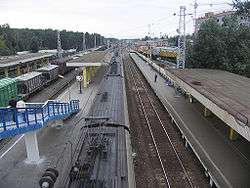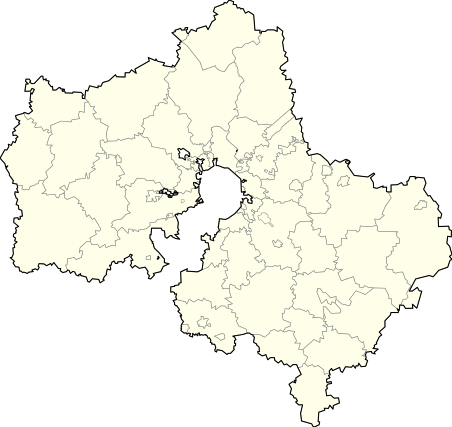Zheleznodorozhny, Moscow Oblast
| Zheleznodorozhny (English) Железнодорожный (Russian) | |
|---|---|
|
- City[1] - (abolished) | |
 Zheleznodorozhny rail station | |
.svg.png) Location of Moscow Oblast in Russia | |
 Zheleznodorozhny | |
|
| |
.png) |
|
|
| |
| Administrative status (as of December 2014) | |
| Country | Russia |
| Federal subject | Moscow Oblast[1] |
| Administratively subordinated to | Zheleznodorozhny City Under Oblast Jurisdiction[1] |
| Administrative center of | Zheleznodorozhny City Under Oblast Jurisdiction[1] |
| Municipal status (as of December 2014) | |
| Urban okrug | Zheleznodorozhny Urban Okrug[2] |
| Administrative center of | Zheleznodorozhny Urban Okrug[3] |
| Mayor[4] | Yevgeny Zhirkov[4] |
| Representative body | City Council[5] |
| Statistics | |
| Population (2010 Census) | 131,257 inhabitants[6] |
| - Rank in 2010 | 126th |
| Time zone | MSK (UTC+03:00)[7] |
| Founded | 1861 |
| City status since | 1952[5] |
| Abolished | January 9, 2015[2] |
| Postal code(s)[8] | 143980 |
| Zheleznodorozhny on Wikimedia Commons | |
Zheleznodorozhny (Russian: Железнодоро́жный) was a city in Moscow Oblast, Russia, located 21 kilometers (13 mi) east of Moscow. It was abolished and merged into the city of Balashikha in January 2015.[2] Population: 131,257 (2010 Census);[6] 103,931 (2002 Census);[9] 97,426 (1989 Census).[10]
History
Founded in 1861 to service the railway station of Obiralovka (Обира́ловка),[5] the settlement became famous as the location where the main character of Leo Tolstoy's 1878 novel Anna Karenina committed suicide. It was renamed Zheleznodorozhny (Russian for "by the railway") in 1939 and granted town status in 1952.[11] In the 1960s the settlements of Kuchino (Ку́чино), Savvino (Са́ввино), Temnikovo (Те́мниково), and Sergeyevka (Серге́евка) became part of Zheleznodorozhny. Kuchino is historically associated with the name of Andrei Bely, the Russian poet who lived there between 1925 and 1931.
In January 2015 Zheleznodorozhny was abolished and its territory merged into the city of Balashikha.[2]
Administrative and municipal status
Within the framework of administrative divisions, it was incorporated as Zheleznodorozhny City Under Oblast Jurisdiction—an administrative unit with the status equal to that of the districts.[1] As a municipal division, Zheleznodorozhny City Under Oblast Jurisdiction was incorporated as Zheleznodorozhny Urban Okrug.[3][2]
Notable people
- Alexandra Snezhko-Blotskaya, animated films director, lived here until her death in 1980.
- Vasili Arkhipov, a Soviet Navy officer, lived in the city until his death in 1998.
References
Notes
- 1 2 3 4 5 Law #11/2013-OZ, rev. prior to December 2014
- 1 2 3 4 5 Law #209/2014-OZ
- 1 2 Law #179/2004-OZ
- 1 2 Yegor Kargalinsky (2013). "Евгений Жирков – мэр, который победил ЖКХ (The Mayor Who Overcame the Public Utility Mafia)". The Weekly Arguments // Аргументы недели. Retrieved January 13, 2014.
- 1 2 3 "The town's history". Chamber of Commerce and Industry. Retrieved January 13, 2014.
- 1 2 Russian Federal State Statistics Service (2011). "Всероссийская перепись населения 2010 года. Том 1" [2010 All-Russian Population Census, vol. 1]. Всероссийская перепись населения 2010 года (2010 All-Russia Population Census) (in Russian). Federal State Statistics Service. Retrieved June 29, 2012.
- ↑ Правительство Российской Федерации. Федеральный закон №107-ФЗ от 3 июня 2011 г. «Об исчислении времени», в ред. Федерального закона №271-ФЗ от 03 июля 2016 г. «О внесении изменений в Федеральный закон "Об исчислении времени"». Вступил в силу по истечении шестидесяти дней после дня официального опубликования (6 августа 2011 г.). Опубликован: "Российская газета", №120, 6 июня 2011 г. (Government of the Russian Federation. Federal Law #107-FZ of June 31, 2011 On Calculating Time, as amended by the Federal Law #271-FZ of July 03, 2016 On Amending Federal Law "On Calculating Time". Effective as of after sixty days following the day of the official publication.).
- ↑ Почта России. Информационно-вычислительный центр ОАСУ РПО. (Russian Post). Поиск объектов почтовой связи (Postal Objects Search) (Russian)
- ↑ Russian Federal State Statistics Service (May 21, 2004). "Численность населения России, субъектов Российской Федерации в составе федеральных округов, районов, городских поселений, сельских населённых пунктов – районных центров и сельских населённых пунктов с населением 3 тысячи и более человек" [Population of Russia, Its Federal Districts, Federal Subjects, Districts, Urban Localities, Rural Localities—Administrative Centers, and Rural Localities with Population of Over 3,000] (XLS). Всероссийская перепись населения 2002 года [All-Russia Population Census of 2002] (in Russian). Retrieved August 9, 2014.
- ↑ Demoscope Weekly (1989). "Всесоюзная перепись населения 1989 г. Численность наличного населения союзных и автономных республик, автономных областей и округов, краёв, областей, районов, городских поселений и сёл-райцентров" [All Union Population Census of 1989: Present Population of Union and Autonomous Republics, Autonomous Oblasts and Okrugs, Krais, Oblasts, Districts, Urban Settlements, and Villages Serving as District Administrative Centers]. Всесоюзная перепись населения 1989 года [All-Union Population Census of 1989] (in Russian). Институт демографии Национального исследовательского университета: Высшая школа экономики [Institute of Demography at the National Research University: Higher School of Economics]. Retrieved August 9, 2014.
- ↑ СССР. Административно-территориальное деление союзных республик на 1 января 1980 года / Составители В. А. Дударев, Н. А. Евсеева. — М.: Изд-во «Известия Советов народных депутатов СССР», 1980. — 702 с. — С. 172.
Sources
- Московская областная Дума. Закон №11/2013-ОЗ от 31 января 2013 г. «Об административно-территориальном устройстве Московской области», в ред. Закона №72/2015-ОЗ от 5 мая 2015 г. «Об отнесении города Озёры Озёрского района Московской области к категории города областного подчинения Московской области, упразднении Озёрского района Московской области и внесении изменений в Закон Московской области "Об административно-территориальном устройстве Московской области"». Вступил в силу на следующий день после официального опубликования (13 января 2013 г.). Опубликован: "Ежедневные Новости. Подмосковье", №24, 12 февраля 2013 г. (Moscow Oblast Duma. Law #11/2013-OZ of January 31, 2013 On the Administrative-Territorial Structure of Moscow Oblast, as amended by the Law #72/2015-OZ of May 5, 2015 On Re-Classifying the Town of Ozyory in Ozyorsky District of Moscow Oblast as the Town Under Oblast Jurisdiction, on Abolishing Ozyorsky District of Moscow Oblast, and on Amending the Law of Moscow Oblast "On the Administrative-Territorial Structure of Moscow Oblast". Effective as of the day following the day of the official publication (January 13, 2013).).
- Московская областная Дума. Закон №179/2004-ОЗ от 21 декабря 2004 г. «О статусе и границе городского округа Железнодорожный», в ред. Закона №8/2011-ОЗ от 28 января 2011 г «О внесении изменений в Закон Московской области "О статусе и границах Ногинского муниципального района и вновь образованных в его составе муниципальных образований" и Закон Московской области "О статусе и границе городского округа Железнодорожный"». Вступил в силу со дня официального опубликования. Опубликован: "Ежедневные Новости. Подмосковье", №248, 30 декабря 2004 г. (Moscow Oblast Duma. Law #179/2004-OZ of December 21, 2004 On the Status and the Border of Zheleznodorozhny Urban Okrug, as amended by the Law #8/2011-OZ of January 28, 2011 On Amending the Law of Moscow Oblast "On the Status and Borders of Noginsky Municipal District and the Newly Established Municipal Formations It Comprises" and the Law of Moscow Oblast "On the Status and the Border of Zheleznodorozhny Urban Okrug". Effective as of the day of the official publication.).
- Московская областная Дума. Закон №209/2014-ОЗ от 30 декабря 2014 г. «Об объединении городов областного подчинения Московской области Балашиха и Железнодорожный и внесении изменения в Закон Московской области "Об административно-территориальном устройстве Московской области"». Вступил в силу через десять дней после официального опубликования. Опубликован: Официальный Интернет-портал Правительства Московской области (http://www.mosreg.ru), 12 января 2015 г. (Moscow Oblast Duma. Law #209/2014-OZ of December 30, 2014 On the Merger of the Balashikha and Zheleznodorozhny Cities Under Oblast Jurisdiction and on Amending the Law of Moscow Oblast "On the Administrative-Territorial Structure of Moscow Oblast". Effective as of the day which is ten days after the official publication.).
External links
- Unofficial website of Zheleznodorozhny (Russian)